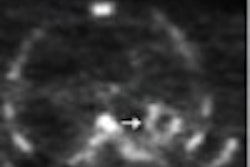Recent reports in the medical literature indicate that PET imaging is effective for the detection of periprosthetic infection. But not surprisingly, given the slow acceptance of PET by payors, this application is not yet reimbursed.
That said, an update on PET given by Dr. Thomas Berquist at the 2003 International Skeletal Society (ISS) meeting in San Francisco featured dramatic images of infection around a patient’s prosthetic leg joint. Berquist, who is based in Jacksonville, FL, spoke optimistically about the future of PET imaging in such cases.
While PET’s detection of infection is slightly more accurate in the axial skeleton than in the peripheral skeleton, its overall sensitivity is 100%, specificity is 93%, and accuracy is 97%, Berquist said.
"This is very encouraging for the future use of PET for this particular problem," the Mayo Clinic specialist said. "Those applications are going to expand, and hopefully the reimbursement will expand with them."
Much of Berquist’s presentation was an overview of the current state of PET imaging for the ISS, whose members include musculoskeletal radiologists, pathologists, orthopedic surgeons, and rheumatologists.
"It is an update because we have a lot of work to do," Berquist said, alluding to both the need to secure reimbursement for additional PET applications and the need to more fully engage radiology residents in the study of nuclear medicine.
Berquist highlighted the areas of musculoskeletal imaging where PET’s effectiveness has been reported in the medical literature, including osteomyelitis and soft-tissue infection. Other relevant applications include metastasis, myeloma, Paget’s disease, muscle metabolism, and primary and secondary neoplasms -- primarily for detection management and response to therapy.
"If you look at the literature for all tumors, it would suggest that PET imaging for neoplasms is 84% sensitive, 88% specific, and changed the management of the patient in 32% of the cases," Berquist said.
He also summarized the areas for which PET is currently being reimbursed by Medicare, which include lung cancer, esophageal cancer, colorectal cancer, lymphoma, melanoma, head and neck cancer, solitary pulmonary nodules, and breast cancer -- for restaging of local recurrence or metastasis and/or for treatment response.
"With regard to metastatic breast cancer, (PET offers) improved sensitivity and accuracy of detection of osseous metastases compared with conventional scintigraphy, and PET is also able to detect metastatic lesions earlier," Berquist said.
In general, Berquist said, "If it’s related in some way to any of the Medicare group indications, many of the third-party payors will reimburse you. If you can prove that its clinically important and significant there are still some that will pay you."
"PET imaging is functional imaging, and I think it holds great promise in musculoskeletal disorders," he added. "So as we expand and hopefully develop more results in the literature, that will continue to improve and the indications will continue to expand."
By Tracie L. ThompsonAuntMinnie.com contributing writer
October 7, 2003
Related Reading
Boning up on musculoskeletal MR basics at ISS, September 18, 2003
Infecton SPECT, FDG-PET illuminate skeletal infections, June 19, 2002
Copyright © 2003 AuntMinnie.com



















